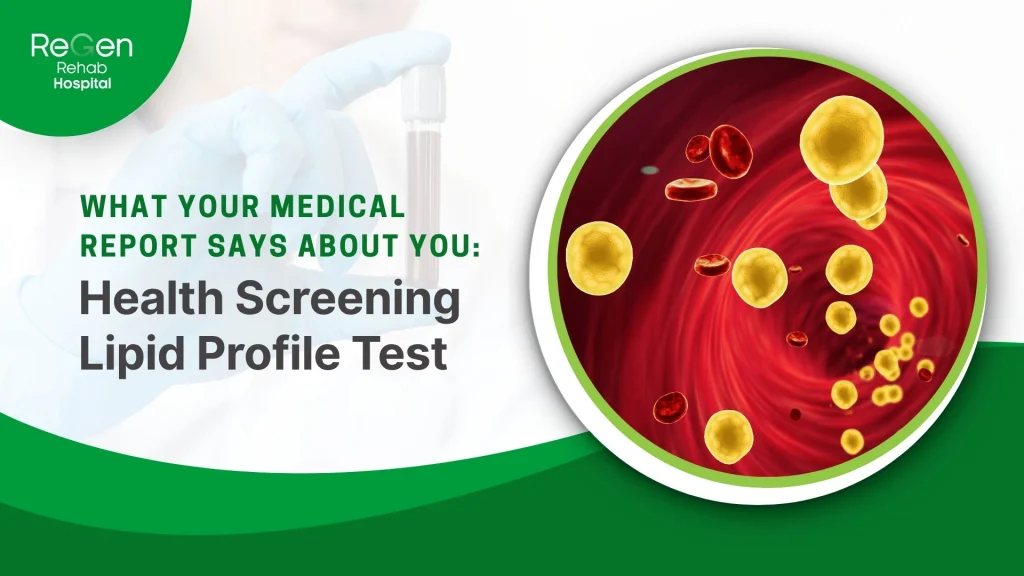Understanding Lipid Studies: A Complete Guide to Cholesterol and Triglycerides
When you receive your health screening results, one of the most important sections is the lipid profile test. This simple blood test measures different types of fats in your bloodstream such as cholesterol and triglycerides that affect your heart and circulation health. Because high cholesterol and triglycerides rarely cause symptoms, regular screening provides valuable insights long before any problems develop.
By understanding your lipid profile test, you can make informed choices about diet, lifestyle, and medical care. This guide explains what your results mean, why they matter, and practical steps to improve them.
What is Total Cholesterol?
Total cholesterol is the overall amount of cholesterol in your blood. It includes:
- High-Density Lipoprotein (HDL): the “good” cholesterol
- Non-HDL cholesterol: includes Low-Density Lipoprotein (LDL, “bad” cholesterol) and other types
While the total figure provides a snapshot, clinicians look at HDL, LDL, and triglycerides separately for a clearer picture of cardiovascular risk.
HDL Cholesterol: The Good Cholesterol
HDL cholesterol is often called the “good” cholesterol because it transports excess cholesterol away from arteries to the liver for removal.
Why high HDL is beneficial?
- Helps protect against heart disease
- Prevents cholesterol build-up in artery walls
- Supports repair and maintenance of healthy cells
- Healthy HDL range: Above 1.03 mmol/L
How to Increase HDL Naturally
- Regular exercise (brisk walking, cycling, swimming)
- Quit smoking; smoking reduces HDL and damages arteries
- Choose healthy fats rich in omega-3 (salmon, mackerel, walnuts, flaxseeds)
LDL Cholesterol: The Bad Cholesterol
LDL cholesterol is labelled “bad” because high levels cause cholesterol to stick to artery walls. Over time, this leads to plaque build-up, narrowing blood vessels and raising heart attack or stroke risk.
Why LDL Matters?
- Excess LDL contributes to blocked arteries
- Increases risk of coronary artery disease, angina, and stroke
- Healthy LDL range: Below 2.6 mmol/L
How to Lower LDL Cholesterol?
- Stop smoking to improve cardiovascular health
- Eat fewer saturated and trans fats; reduce fried foods, processed snacks, fatty meats
- Exercise regularly to lower LDL and raise HDL
- Maintain a healthy weight; even modest loss helps
- Limit alcohol; excess raises cholesterol and triglycerides
- For Asians, keeping BMI below 23 and body fat under 28% (women) and 20% (men) is recommended. Replace refined carbohydrates with vegetables, pulses, and whole grains.
Triglycerides: Understanding the Energy Storage Fat
Triglycerides are fats formed when unused calories are converted and stored. While they provide energy, elevated levels increase heart risk.
Why high triglycerides are dangerous
- Linked to eating more calories than burned
- Associated with obesity, type 2 diabetes, and heart disease
- Excess can contribute to stroke and metabolic syndrome
- Healthy triglyceride range: Below 1.7 mmol/L
How to Reduce Triglyceride Levels
- Lose weight; even modest reduction lowers levels
- Eat a balanced diet with vegetables, fruits, whole grains, lean proteins
- Exercise regularly to burn calories and reduce fat storage
- Limit alcohol; it adds calories and sugars
- Follow low-fat, low-carb diet if advised
- Consider medication if lifestyle is insufficient
- Reduce added sugars and sweetened drinks
Why Lipid Studies Matter
Your lipid profile is a key indicator of heart health. High cholesterol and triglycerides are usually symptomless yet raise the risk of life-threatening conditions. Taking action early prevents serious problems.
Key Takeaways
- High HDL protects your heart
- High LDL and triglycerides increase heart attack and stroke risk
- Small lifestyle changes (exercise, diet, not smoking) matter
- Consult your doctor for personalised advice and treatment
- Set targets with your clinician and re-test periodically
Understanding Your Lipid Profile Test Results
Your lipid profile report lists each parameter with measured values and reference ranges. Values outside the normal range do not always indicate serious disease, as diet, hydration, physical activity, and medications can influence results. Here’s a general reference for common parameters:
Lipid Profile Test Reference Table
| Parameter | Common Adult Male Range | Common Adult Female Range | Unit | What It Measures |
|---|---|---|---|---|
| Total Cholesterol | < 5.20 | mmol/L | The total amount of cholesterol in your blood, including both good (HDL) and bad (LDL) cholesterol. High levels may increase heart disease risk. | |
| HDL-Chol (good) | > 1.03 | mmol/L | “Good” cholesterol that helps remove excess cholesterol from the bloodstream and protects against heart disease. Higher values are beneficial. | |
| Non-HDL-Chol (bad) | < 3.37 | mmol/L | The total of all “bad” cholesterol types (LDL, VLDL, etc.) that can build up in arteries. Lower values reduce cardiovascular risk. | |
| LDL-Chol (bad) | < 2.60 | mmol/L | “Bad” cholesterol that contributes to plaque buildup in blood vessels, increasing the risk of heart attack and stroke. | |
| Triglycerides | < 1.70 | mmol/L | A type of fat in the blood that stores excess energy. High levels are linked to insulin resistance and cardiovascular disease. | |
| Total/HDL-Chol Ratio | < 5.00 | Index | The ratio of total cholesterol to good cholesterol (HDL). A higher ratio indicates greater heart disease risk. | |
| Homocysteine | 5.0 – 15.0 | umol/L | An amino acid linked to vitamin B12 and folate metabolism. Elevated levels may increase risk of blood vessel damage and heart disease. | |
| Apolipoprotein A1 | 1.05 – 1.75 | 1.05 – 2.05 | g/L | The main protein component of HDL (“good” cholesterol). Higher levels are associated with lower cardiovascular risk. |
| Apolipoprotein B | 0.60 – 1.40 | 0.55 – 1.30 | g/L | The main protein component of LDL (“bad” cholesterol). Elevated levels indicate higher cardiovascular risk. |
| Apo-B/A1 Ratio | Risk: Average 0.6 – 0.8, High > 0.8 | index | A calculation of apolipoprotein B (Apo B) divided by apolipoprotein A1 (Apo A1), used as a marker for cardiovascular disease risk. | |
| Lactate Dehydrogenase (LDH) | < 248 | < 247 | U/L | An enzyme found in most body tissues. Elevated levels can indicate tissue damage, heart stress, or liver/muscle injury. |
| High Sensitive Troponin I | < 34.2 | < 15.6 | pg/ml | A cardiac biomarker that detects even minor heart muscle injury. High values may indicate heart strain or early cardiac disease. |
| CVD Risk-Stratification (Risk): Low Moderate Elevated | < 6 > 6 - < 12 > 12 | < 4 > 4 - <10 > 10 | - | A combined score estimating overall cardiovascular disease (CVD) risk based on multiple blood markers. Higher scores reflect greater risk. |
| High Sensitive C-Reactive Protein (hsCRP) CVD Risk: Low High Inflammation | < 1.0 > 3.0 > 10 | mg/L | A marker of inflammation in the body, may also be used to indicate cardiovascular risk | |
It is important to remember that abnormal lipid results do not always indicate a serious medical condition. Many factors such as recent meals, stress, and certain medications can temporarily influence your lipid levels. Our doctor will consider your overall health, medical history, and other relevant tests to provide an accurate diagnosis and guide the next steps in your care.
Common Signs of Unhealthy Cholesterol or Lipid Imbalance
High cholesterol or triglycerides usually cause no obvious symptoms, but long-term elevation can silently damage blood vessels. Warning signs may include:
- Chest pain or pressure (angina)
- Shortness of breath
- Fatigue during physical activity
- Leg cramps or numbness due to poor circulation
- Xanthomas (yellowish fatty deposits under the skin)
If you experience any of these symptoms, consult a healthcare professional promptly for evaluation.
Who Should Get Tested Regularly?
You may need regular lipid profile tests if you have or fall into any of the following groups:
- Diabetes, hypertension, or obesity
- Family history of heart disease or stroke
- Sedentary lifestyle or unhealthy diet
- Smoke or consume alcohol frequently
- Age over 40 (for men) or over 50 (for women)
- Taking long-term medications affecting cholesterol (e.g., steroids, beta-blockers, birth control pills)
Regular screening helps detect issues early and allows you to make lifestyle or medical adjustments to maintain heart health.
Taking Care of Your Heart Health
Taking care of your cholesterol and triglyceride levels is one of the best ways to protect your heart. With a balanced diet, regular exercise, and simple lifestyle changes, you can significantly reduce cardiovascular risk and improve your long-term well-being.
If your lipid results are outside the healthy range, talk to your clinician about a personalised plan. Taking proactive steps today ensures a stronger, healthier tomorrow. Regular screening every 6 to 12 months helps track your progress and guide any necessary adjustments.
Now that you understand lipid and cardiovascular screening, remember that heart health isn’t defined by a single number. It’s about consistent habits over time. Managing HDL, LDL, and triglycerides not only reduces heart disease risk but also boosts your daily energy and vitality.
Safeguard your heart health today. Book a comprehensive health screening and take charge of your long-term vitality and well-being.

